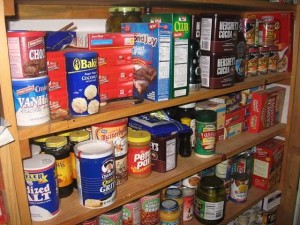by Nick Romaniello
I’m sure there are plenty of preppers out there that wouldn’t break into their mylar pouches full of grain for anything short of total Armageddon, but the truth is that emergencies can be varied and subjective. The world of a self-employed home improvement contractor is sometimes one of feast or  famine especially during the initial years of building a business. The last few months have been financially tricky for me and Mighty Oak Homecraft. Large jobs have run long, delaying the income from final payments. Taxes were due, materials need purchased, yearly renewals of licenses and websites have all converged into a financial super-storm; the result is a cartoon-like escape of moths and dust when I open my wallet.
famine especially during the initial years of building a business. The last few months have been financially tricky for me and Mighty Oak Homecraft. Large jobs have run long, delaying the income from final payments. Taxes were due, materials need purchased, yearly renewals of licenses and websites have all converged into a financial super-storm; the result is a cartoon-like escape of moths and dust when I open my wallet.
There is relief on the horizon as more jobs fill the schedule, but when the bank account hovers near the red it‘s nice to have a backup plan so that “feast or famine“ remains only a metaphor. Luckily there isn’t any panic about the financial burden of buying groceries. While I am not yet set up to last for months without resupply, having a reasonable store of food on hand to help stretch out limited resources is a big help. A lean month or two may not be the dramatic type of disaster scenario that many preppers are fortifying themselves against, but in reality (especially in my business) it’s a fairly likely scenario. Even for those with more predictable paychecks, financial emergencies can strike without warning. Unexpected car problems, a layoff, or an injury can put a serious dent in your cash flow. Emergency funds and savings accounts can be an ideal stopgap, but it can be difficult to squirrel away cash if you are living paycheck to paycheck. Being prepared should not be an exclusive hobby for those who can afford to stack gold bars up in their bunker. Even us penny pinchers can pick up a few extra cans each time we shop and before you know it, you have a food cache. Same goes for every gallon of gas you put away. An extra tank full when the chips are down could keep you operational when you might otherwise be thumbing rides.
 Full scale financial collapse will always be a hot topic in prepping circles and forums, but the commonality of family level tough periods exemplifies the purpose of prepping. It’s not always about the big things that might happen, but more about the small things that probably will happen. Don’t allow yourself to develop a mindset that your preps are only for “the big one”. They are your way of providing help to yourself in the future. Just like any other type of insurance policy, you aren’t required to wait for total loss to make a claim. There are preps that we acquire with the hope and intent that we never need to use them such as a fire ladder, gun, or suture kit. However, some items that we store such as food, gas, or toiletries don’t need to be viewed as such a last resort — plus they need to be rotated anyway! If you are hungry, eat. There is no shame in using your preps for small, short-lived emergencies. Things will get better and you can stock up again. That’s what it’s there for.
Full scale financial collapse will always be a hot topic in prepping circles and forums, but the commonality of family level tough periods exemplifies the purpose of prepping. It’s not always about the big things that might happen, but more about the small things that probably will happen. Don’t allow yourself to develop a mindset that your preps are only for “the big one”. They are your way of providing help to yourself in the future. Just like any other type of insurance policy, you aren’t required to wait for total loss to make a claim. There are preps that we acquire with the hope and intent that we never need to use them such as a fire ladder, gun, or suture kit. However, some items that we store such as food, gas, or toiletries don’t need to be viewed as such a last resort — plus they need to be rotated anyway! If you are hungry, eat. There is no shame in using your preps for small, short-lived emergencies. Things will get better and you can stock up again. That’s what it’s there for.


